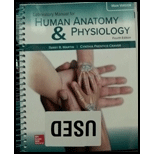
Concept explainers
Introduction:
Antigens are the substances which are specifically bounded by antibodies. It is a structural molecule that binds specifically to an antibody only in the form of a native antigen. It evokes an immune response either alone or forming a complex with larger molecules and that is capable of binding with a product of the immune response.
Answer to Problem 1PL
Correct answer:
The correct answer is option (a) on the red blood cell membranes.
Explanation of Solution
Explanation/justification for the correct answer:
Option (a) on the red blood cell membranes. The blood typing involves the identifying of protein substances called antigens, present on the outer surface of the red blood cell membranes. These include the antigens of the ABO group and those of the Rh group. The ABO blood group antigens are attached to the oligosaccharide chains that project over the surface of red blood cells. These chains are attached to proteins and lipids that lie over the surface of the red blood cell membrane. So, the correct answer is option (b).
Explanation for incorrect answer:
Option (b) within the red blood cell nucleus. The ABO blood group antigens are attached to the oligosaccharide chains that project over the surface of red blood cells and not within the nucleus. Also, the red blood cells are devoid of nucleus. So, this is an incorrect option.
Option (c) within the red blood cell cytosol. The ABO blood group antigens are attached to the oligosaccharide chains that project over the surface of red blood cells and not within the cytosol. So, this is an incorrect answer.
Option (d) on the surface of red blood cell ribosome. The ABO blood group antigens are attached to the oligosaccharide chains that project over the surface of red blood cells. These chains are attached to proteins and lipids that lie over the surface of the red blood cell membrane and not ribosome. So, this is an incorrect answer.
Thus, the antigens related to the ABO blood group are located on the surface of the red blood cell membranes.
Want to see more full solutions like this?
Chapter 43 Solutions
Laboratory Manual For Human Anatomy & Physiology
- Amino Acid Coclow TABle 3' Gly Phe Leu (G) (F) (L) 3- Val (V) Arg (R) Ser (S) Ala (A) Lys (K) CAG G Glu Asp (E) (D) Ser (S) CCCAGUCAGUCAGUCAG 0204 C U A G C Asn (N) G 4 A AGU C GU (5) AC C UGA A G5 C CUGACUGACUGACUGAC Thr (T) Met (M) lle £€ (1) U 4 G Tyr Σε (Y) U Cys (C) C A G Trp (W) 3' U C A Leu בוט His Pro (P) ££ (H) Gin (Q) Arg 흐름 (R) (L) Start Stop 8. Transcription and Translation Practice: (Video 10-1 and 10-2) A. Below is the sense strand of a DNA gene. Using the sense strand, create the antisense DNA strand and label the 5' and 3' ends. B. Use the antisense strand that you create in part A as a template to create the mRNA transcript of the gene and label the 5' and 3' ends. C. Translate the mRNA you produced in part B into the polypeptide sequence making sure to follow all the rules of translation. 5'-AGCATGACTAATAGTTGTTGAGCTGTC-3' (sense strand) 4arrow_forwardWhat is the structure and function of Eukaryotic cells, including their organelles? How are Eukaryotic cells different than Prokaryotic cells, in terms of evolution which form of the cell might have came first? How do Eukaryotic cells become malignant (cancerous)?arrow_forwardWhat are the roles of DNA and proteins inside of the cell? What are the building blocks or molecular components of the DNA and proteins? How are proteins produced within the cell? What connection is there between DNA, proteins, and the cell cycle? What is the relationship between DNA, proteins, and Cancer?arrow_forward
- please fill in the empty sports, thank you!arrow_forwardIn one paragraph show how atoms and they're structure are related to the structure of dna and proteins. Talk about what atoms are. what they're made of, why chemical bonding is important to DNA?arrow_forwardWhat are the structure and properties of atoms and chemical bonds (especially how they relate to DNA and proteins).arrow_forward
- The Sentinel Cell: Nature’s Answer to Cancer?arrow_forwardMolecular Biology Question You are working to characterize a novel protein in mice. Analysis shows that high levels of the primary transcript that codes for this protein are found in tissue from the brain, muscle, liver, and pancreas. However, an antibody that recognizes the C-terminal portion of the protein indicates that the protein is present in brain, muscle, and liver, but not in the pancreas. What is the most likely explanation for this result?arrow_forwardMolecular Biology Explain/discuss how “slow stop” and “quick/fast stop” mutants wereused to identify different protein involved in DNA replication in E. coli.arrow_forward
 Human Heredity: Principles and Issues (MindTap Co...BiologyISBN:9781305251052Author:Michael CummingsPublisher:Cengage Learning
Human Heredity: Principles and Issues (MindTap Co...BiologyISBN:9781305251052Author:Michael CummingsPublisher:Cengage Learning Human Physiology: From Cells to Systems (MindTap ...BiologyISBN:9781285866932Author:Lauralee SherwoodPublisher:Cengage Learning
Human Physiology: From Cells to Systems (MindTap ...BiologyISBN:9781285866932Author:Lauralee SherwoodPublisher:Cengage Learning Human Biology (MindTap Course List)BiologyISBN:9781305112100Author:Cecie Starr, Beverly McMillanPublisher:Cengage Learning
Human Biology (MindTap Course List)BiologyISBN:9781305112100Author:Cecie Starr, Beverly McMillanPublisher:Cengage Learning





